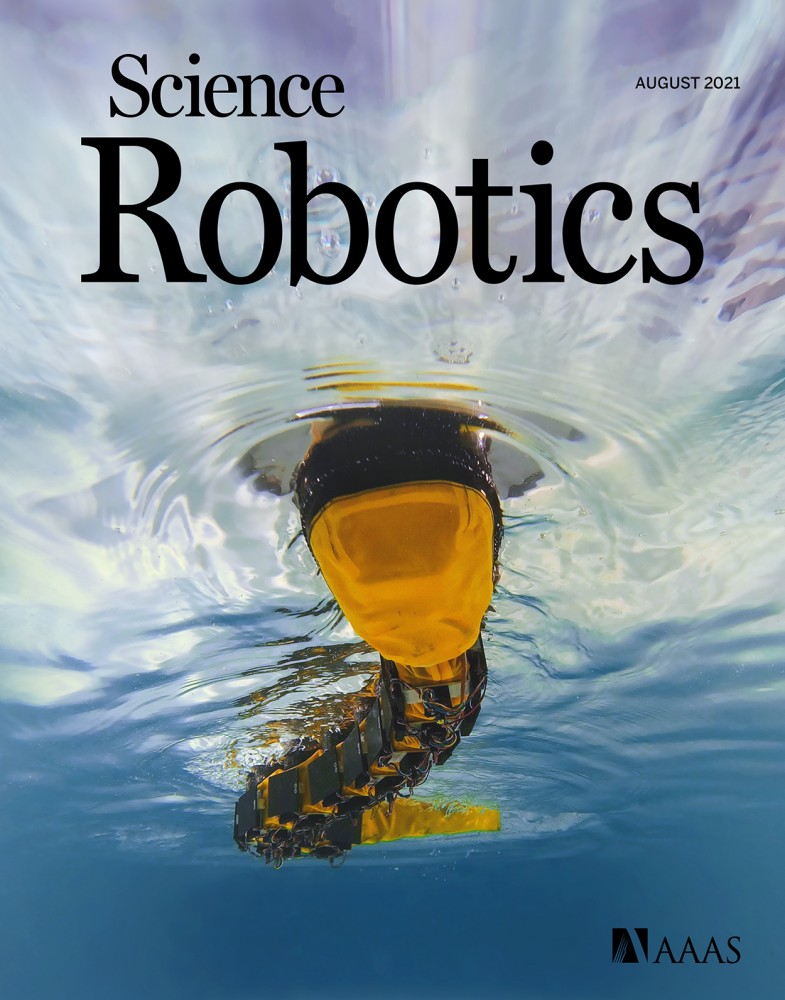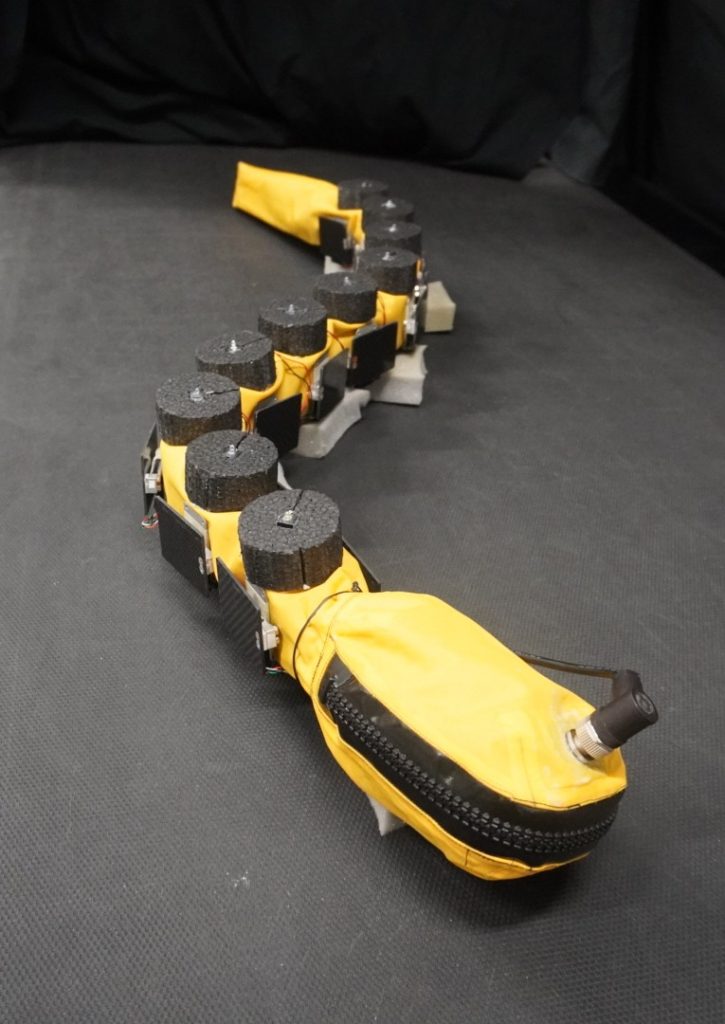Together with colleagues from Japan (Tohoku University), France (Institut Mines-Télécom Atlantique in Nantes) and Canada (Université de Sherbrooke), we are glad to present our latest study that was published in Science Robotics:
 Emergence of Robust Self-Organized Undulatory Swimming Based on Local Hydrodynamic Force Sensing. Robin Thandiackal*, Kamilo Melo*, Laura Paez, Johann Herault, Takeshi Kano, Kyoichi Akiyama, Frédéric Boyer, Dimitri Ryczko, Akio Ishiguro, Auke J. Ijspeert. *These authors contributed equally to this work. Science Robotics 11 Aug. 2021: Vol. 6, Issue 57, eabf6354. DOI: 10.1126/scirobotics.abf6354
Emergence of Robust Self-Organized Undulatory Swimming Based on Local Hydrodynamic Force Sensing. Robin Thandiackal*, Kamilo Melo*, Laura Paez, Johann Herault, Takeshi Kano, Kyoichi Akiyama, Frédéric Boyer, Dimitri Ryczko, Akio Ishiguro, Auke J. Ijspeert. *These authors contributed equally to this work. Science Robotics 11 Aug. 2021: Vol. 6, Issue 57, eabf6354. DOI: 10.1126/scirobotics.abf6354
You can find direct links to the summary, the abstract, the reprint and the full-text of the article. As part of this publication, we also created an interactive website for readers to interact with our data https://go.epfl.ch/AgnathaX and explore our results.
For more info and metrics click here.
We developed an undulatory swimming robot equipped with distributed force sensors to study the neural mechanisms controlling locomotion in the spinal cord. Our two main findings are: (i) both the central nervous system and the peripheral nervous system contribute to the generation of robust locomotion, and together they offer remarkable robustness against lesions/defaults, and (ii) force sensors in the skin of animals and robots (that sense how much the water pushes against the body) and the physical interactions of the body and the water can provide very useful signals that help generate and synchronize the rhythmic muscle activity necessary for locomotion.

The spinal cord and its role in locomotion
Over the past decades undulatory swimming organisms like lampreys, eels and salamanders have helped scientists to expand our knowledge of neural control. From these animals we have learned in large parts how the nervous system in vertebrates controls cyclic body motions to locomote from one place to another. Swimming is generated by coordinating and sending waves of muscle activations from head to tail.
We know that locomotion in vertebrate animals is due to the interactions of the central nervous system (neural circuits in the brain and in the spinal cord), the peripheral nervous system (the nerves that project to the muscles and all the sensory neurons that provide information to the central nervous system), the body, and the environment. We also know that many of the basic control structures underlying undulatory swimming are located in the spinal cord. There are mainly two mechanisms at work:
- Central mechanisms: They involve so-called central pattern generators (CPGs), which represent distributed populations of neurons that generate rhythmic patterns which are then sent to the muscles to induce rhythmic movements.
- Peripheral mechanisms: They relate to the peripheral nervous system (the periphery of the body and the interface between body and environment) and rely on sensory information (e.g. touch, pressure, etc.) of the environment.
Although previous studies have identified these mechanisms, it remains partially unknown how they play together and how they ultimately generate and modulate locomotion patterns. In this study, we investigated the interplay of these central and peripheral mechanisms with the help of a purposefully designed swimming robot.
AgnathaX: A robot that can sense the forces from the water
How the nervous system incorporates sensory information and generates motion patterns is generally hard to analyze within a living organism because it is difficult to separate the highly interconnected central and peripheral components in the spinal cord. The underlying idea in this study is to substitute the dynamics of the nervous system by a set of mathematical equations while the animal body is replaced by a robotic counterpart. The advantage of this approach is that we can specifically monitor the different central and peripheral inputs and outputs in the nervous system, and selectively activate and deactivate them. Subsequently, we derive a more clear understanding of how locomotion is generated, controlled and regulated.
In this study, we designed AgnathaX, an elongate undulatory swimming robot which emulates the lamprey. The robot incorporates the main characteristics of this animal that are relevant for locomotion control.
A robust interplay based on redundancy
Although it is possible to swim without any sensing, exclusively based on control from CPGs, we found that a system including the peripheral components and an entrainment mechanism was significantly more robust to neural disruptions and was able to sustain forward swimming much better. Tested disruptions were failures in the communication between spinal cord segments, muted CPGs and muted sensors. In these cases when central and peripheral components were working together, they helped to conserve stable swimming patterns and higher swimming speeds. Locomotion can be seen as an emergent and self-organized phenomenon due to these interactions, and hence the title of our article (Emergence of Robust Self-Organized Undulatory Swimming).

Implications both for neuroscience and robotics
Our results show that both the central and the peripheral nervous systems have mechanisms to generate swimming, and that together they produce more robust swimming than any of these alone. In particular, our study confirms that there are important functions provided by peripheral mechanisms that might be “hidden” by well-known central mechanisms. These peripheral mechanisms could play an important role in the recovery of motor function after spinal cord injury as no-a-priori connections within the spinal cord are necessary to maintain a traveling wave along the body.
Although AgnathaX was designed with the goal to study neural control of swimming locomotion, this study also provides novel insights for robotics:
- Using the entrainment mechanism no explicit communication between modules is necessary because swimming emerges in a self-organized manner. As a result such a system exhibits scalable characteristics that supports easy construction and deployment of many modular swimming units with a high degree of reconfiguration and robustness, e.g. for search and rescue missions or environmental monitoring
- The custom designed sensing units provide a new way of accurate force sensing in water along the entirety of the body and could therefore potentially be used to navigate through flow perturbations and enable advanced maneuvers in unsteady flows
- Our work provides design principles for making robots that are remarkably fault-tolerant and robust against damage in their sensors, communication buses, and control circuits.
Interactive Website:
Results of this work can be explored in the interactive website:
https://go.epfl.ch/AgnathaX
Media Kit:
A media kit was prepared and can be found here. It contains figures and videos of AgnathaX (with credits information) as well as a press release and a document with F.A.Q.